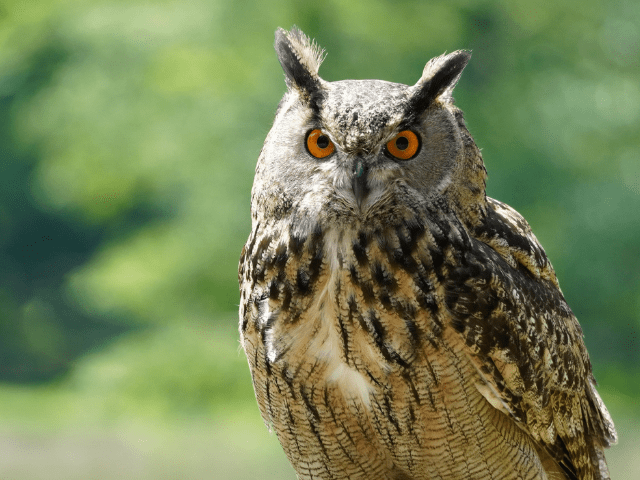If you're planning a trip to Pennsylvania's state parks and forests, you're in for a treat because you may witness some of the local owls as you bask in the state's natural beauty!
Eight owl species are present in the state - six of them are seen all year round.
While...
The other two are only seen in the winter. That’s why we've compiled the necessary information about each owl so you can identify one when you go birding. Read on to learn about the owls in Pennsylvania!
Permanent Residents
1. Barn Owl (Tyto furcata)

Measurements
Length: 12.6-15.8 in (32-40 cm)
Weight: 14.1-24.7 oz (400-700 g)
Wingspan: 39.4-49.2 in (100-125 cm)
Appearance
This medium-sized owl is easily distinguished by its white heart-shaped facial disk. Its long legs are also exposed, compared to other owls who hide them with their plumage. There are also no ear tufts.
The upperparts are a mix of orange, brown, and gray, while the underparts are white with small black spots. Both sexes look alike, but females tend to be darker.
Diet
Their diet consists of rodents such as voles, mice, and rats, but they also eat other small mammals, insects, and small birds.
Barn Owls are great to attract if you own an agricultural area because they're known for controlling rodents better than traps or poison.
Habitat
The Barn Owl has a vast range of habitats, from rural to urban. For hunting, open areas are essential such as grasslands, marshes, or mixed agricultural regions.
Meanwhile, it prefers a quiet cave or tree cavity for nesting and roosting but can also go to artificial structures such as a barn loft, a nest box, or an abandoned house.
Most Barn Owl sightings occur in the southern regions of Pennsylvania. You can also see more of them during the breeding season (March and April) as they are most active then. However, they are not common for the rest of the year.
2. Barred Owl (Strix varia)

Measurements
Length: 16.9-19.7 in (43-50 cm)
Weight: 16.6-37.0 oz (470-1050 g)
Wingspan: 39.0-43.3 in (99-110 cm)
Appearance
Slightly larger than the previous Barn Owl, the Barred Owl has many patterns that you can identify.
Overall, there is a brown and white bar pattern on its feathers, hence the name. The upperparts have horizontal bars, while the underparts are vertical.
Additionally, there are brown and white rings around its eyes and a lack of ear tufts.
Diet
Its diet consists mainly of small mammals like rodents, but also frogs, insects, and birds such as woodpeckers.
The barred owl may also take aquatic prey like crayfish, which may result in pink belly feathers!
Habitat
Barred Owls prefer living in wooded swamps and mature forests of deciduous and evergreen trees, often near water.
Typical nesting sites are in tree cavities or old nests from a hawk, raven, or squirrel. They rarely nest on the ground.
Barred Owls quietly roost in the day and hunt in the night, so you're likely to hear them during nighttime.
3. Eastern Screech Owl (Megascops asio)
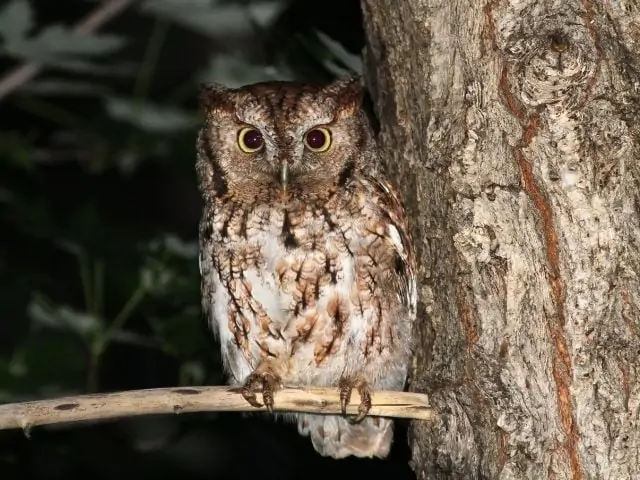
Measurements
Length: 6.3-9.8 in (16-25 cm)
Weight: 4.3-8.6 oz (121-244 g)
Wingspan: 18.9-24.0 in (48-61 cm)
Appearance
This small owl species can appear in two color schemes - gray (gray morph) or reddish-brown (rufous morph). These two colors are mixed with white to form many patterns, allowing the Screech Owl to camouflage with the tree bark.
It can also be distinguished by its small ear tufts and yellow eyes.
Diet
The Eastern Screech Owl has a varied diet, from small rodents to large insects, lizards, spiders, crayfish, and other small creatures. Surprisingly, the Eastern Screech Owl's diet also includes bats.
Habitat
Wherever there are trees, there are Eastern Screech Owls. They reside in most types of woodlands and even wooded parks and suburban areas, typically near water.
They are known cavity nesters, particularly in natural hollows and abandoned nests. They can also visit an artificial nest box.
The Eastern Screech Owl seems to be evenly distributed throughout Pennsylvania, so you don't have to do much traveling around the state to see one.
4. Great Horned Owl (Bubo virginianus)

Measurements
Length: 18.1-24.8 in (46-63 cm)
Weight: 32.1-88.2 oz (910-2500 g)
Wingspan: 39.8-57.1 in (101-145 cm)
Appearance
Despite its name, this large owl doesn't have any horns. Instead, its long and pointed ear tufts look like horns on a silhouette.
It has a mottled gray and brown plumage with a horizontal bar pattern on its underparts. It also has a rufous facial disk and a white patch by the throat.
Diet
Compared to the other owls in this list, the Great Horned Owl can consume a variety of larger mammals and birds such as skunks, snakes, geese, hawks, and smaller owls like the Barn Owl and Screech Owl.
Habitat
This species has a broad range of habitats, from forests, deserts, and cities. During nesting, it prefers caves, cliff edges, or old nests from large birds such as the Bald Eagle.
Being one of the most widespread in North America, the Great Horned owl is seen throughout all regions of Pennsylvania. It's also most active during the winter, so there's a higher chance of sightings.
5. Long Eared Owl (Asio otus)
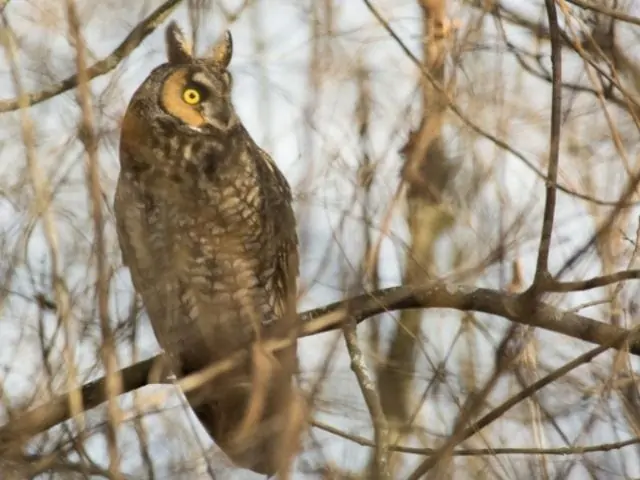
Measurements
Length: 13.8-15.8 in (35-40 cm)
Weight: 7.8-15.3 oz (220-435 g)
Wingspan: 35.4-39.4 in (90-100 cm)
Appearance
This fairly dark bird is a mix of black, brown, and orange, with heavy streaks on its underparts. It has a rufous facial disk with two vertical white lines between the eyes until under its bill.
Diet
Like the other owls in this list, the Long Eared Owl consumes voles, mice, rats, and gophers, but also small birds, snakes, bats, and other small creatures.
Habitat
This species lives in open forests or grasslands/shrublands that are close to vegetation for foraging.
Meanwhile, it prefers dense and tall shrubs for nesting and roosting. Long Eared Owls have an unusual trait where they have communal nesting in thickets during the winter.
They are seen all year but can also migrate during the breeding season. Sightings are less common in central Pennsylvania while more common in northwestern regions of the state.
6. Northern Saw Whet Owl (Aegolius acadicus)
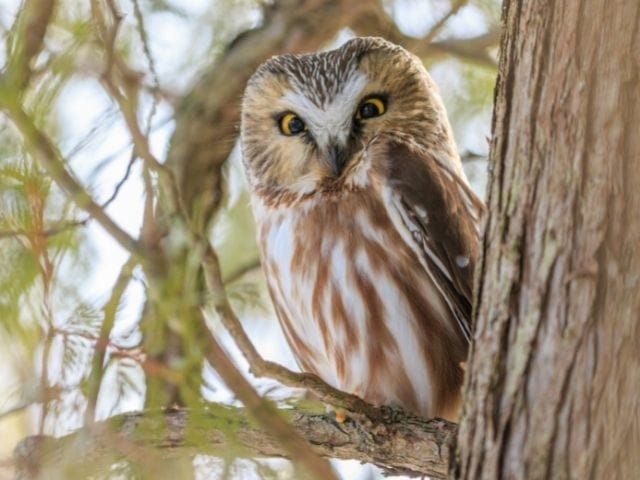
Measurements
Length: 7.1-8.3 in (18-21 cm)
Weight: 2.3-5.3 oz (65-151 g)
Wingspan: 16.5-18.9 in (42-48 cm)
Appearance
This species, which is the smallest Pennsylvania owl, has brown upperparts with white spots, while its underparts are white with thick brown stripes.
It has a large head with yellow eyes, a white letter "Y" between its eyes, and no ear tufts.
Diet
The Northern Saw Whet Owl primarily eats forest rodents such as deer mice, but can also eat other small mammals, birds, and insects.
Habitat
This owl is known as a forest bird, residing in dense coniferous or mixed hardwood forests.
For nesting, it uses the former cavities of woodpeckers and artificial nest boxes as well. Apparently, it avoids using the same nest two years in a row.
This nocturnal owl is seen all year round, but only in northwest Pennsylvania. However, you may still find them in other regions of the state when they expand their hunting range once the breeding season ends.
Winter Visitors
1. Short Eared Owl (Asio flammeus)

Measurements
Length: 13.4-16.9 in (34-43 cm)
Weight: 7.3-16.8 oz (206-475 g)
Wingspan: 33.5-40.5 in (85-103 cm)
Appearance
The medium-sized Short Eared Owl (as you may have guessed) has small ear tufts. It has a large white facial disk with black around the eyes.
Meanwhile, its upperparts are a pattern of light and dark brown spots, while its underparts are pale with thin brown streaks.
Diet
It feeds mostly on voles, but also other rodents like lemmings, deer mice, muskrats, and pocket mice.
Small mammals, bats (rarely), and birds are also part of a short eared owl's diet.
Habitat
Short Eared Owls are often found perched on a low tree or the ground on open areas, such as grasslands, agricultural areas, tundras, and more.
They also rarely nest above ground, as they prefer nesting in a soil depression among the grass or under a shrub.
They go back north once winter is over, although some remain to become permanent residents in northern Pennsylvania.
2. Snowy Owl (Bubo scandiacus)
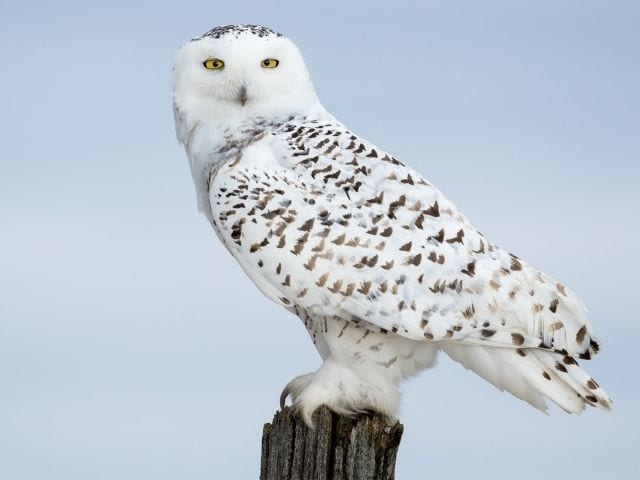
Measurements
Length: 20.5-27.9 in (52-71 cm)
Weight: 56.4-104.1 oz (1600-2950 g)
Wingspan: 49.6-57.1 in (126-145 cm)
Appearance
The largest owl on this list doesn't only get its name from its snowy habitat, but also from its snow-like appearance.
It has some black spots over its white body. This pattern is typically more intense in females, giving them a salt-and-pepper look.
Diet
Its prey varies depending on the habitat.
In the arctic, it feeds primarily on small mammals, especially lemmings. On the other hand, it consumes many birds and fish on the coastlines.
Habitat
This species is typically found near the ground on open lakeshores, marshes, or marine coastlines. It can also be found roosting on top of buildings in urban areas.
For nesting, it prefers the treeless arctic tundra, typically in an elevation such as the top of a mound.
From its original arctic habitat, the Snowy Owl migrates only until the northernmost areas of Pennsylvania. This owl is quite a rare sight in the state because it's already at the southern edge of its winter migration range.
Fun Fact: The Snowy Owl could also be seen frequenting the state of Colorado during the winter season!
Frequently Asked Questions
Why do some owls only visit during the winter?
The two owls mentioned earlier only visit Pennsylvania during the winter season as a result of irruption. Irruption occurs when a bird species moves toward the south in large numbers.
Watch this video of Snowy Owl Irruption:
This migration phenomenon varies between birds, but owls typically do this because the snow from their original habitat makes prey less accessible. Therefore, they move south where there is a better food supply.
Can I capture owls in Pennsylvania?
No, you can't! Doing so would get you punished because all the owls on this list are protected by the Migratory Birds Treaty Act (MBTA).
Plus, you would be destroying the local ecosystem of Pennsylvania. News shows that species such as the Great Horned Owl and Long Eared Owl are declining in the state. Capturing them will endanger them further!
Why is the owl population in Pennsylvania declining?
One of the reasons is their loss of habitat. Many human activities, such as logging and agriculture, require us to chop down trees, which are the preferred homes of many owls.
Another reason is the lack of food resources, especially during harsh snow because prey is harder to find. Some farms also use insecticides and rodenticides for pest control. Once owls consume insects and rodents sprayed with poison, they become poisoned as well.
Conclusion
Being a birder is quite the experience, but you still need to be careful - owls tend to be territorial, so it's best to observe them from afar.
When you visit Pennsylvania's natural sights, be sure to remember which parts of the state these owls are in, their migration patterns, and when they are most active, so you won't miss out.
What are you waiting for? See what wildlife Pennsylvania has to offer!

